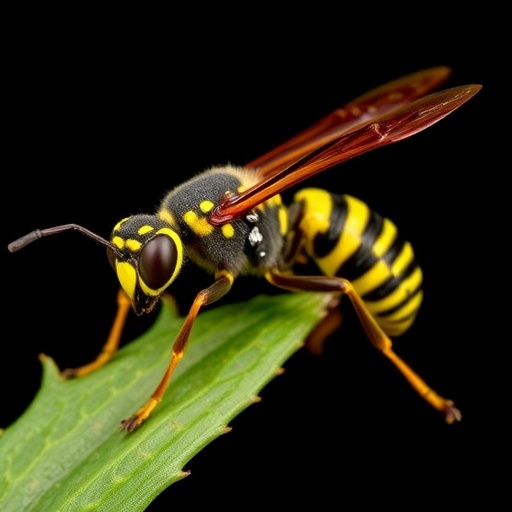A groundbreaking discovery has emerged from the biological sciences community, revealing two previously unrecognized species of parasitic wasps within the United States. These diminutive yet ecologically profound insects, part of the genus Bootanomyia within the family Megastigmidae, have now been confirmed to be introduced species from Europe. This revelation not only deepens our understanding of the expansive biodiversity present in North American ecosystems but also raises provocative questions about biological invasions and ecological interactions in an increasingly globalized world.
Parasitic wasps, although modest in size—ranging merely from one to eight millimeters—play an outsized role in shaping terrestrial ecosystems. They are intimately linked with oak gall wasps, small insects responsible for inducing galls, which are abnormal plant tissue proliferations that range vastly in size and morphology. These galls, often tumor-like or bearing intricate shapes reminiscent of sea urchins or ornate saucers, serve as microhabitats and nurseries for the developing gall wasps and their parasites. The wasps’ ability to manipulate plant tissues to create such niches exemplifies a unique evolutionary adaptation, and the parasitic wasps exploit these galls by laying their eggs within, often leading to the consumption of the original gall wasp larvae.
Scientific efforts to catalog biodiversity in this domain have underscored the sheer richness of species involved. North America hosts approximately 90 oak species and an estimated 800 species of gall wasps specializing on these trees. Within this complex web, numerous parasitic hymenopterans, such as the newly identified Bootanomyia species, orchestrate a biological arms race with their hosts. Researchers, leveraging advanced molecular tools such as mitochondrial Cytochrome Oxidase Subunit I (mtCOI) gene sequencing, have elucidated cryptic diversity among these wasps that would remain obscured by morphology alone due to their minute size and subtle phenotypic differences.
The newly discovered parasitic wasps belong to two distinct genetic clades of Bootanomyia dorsalis, revealing a dual introduction event into North America. Samples from the West Coast, spanning from Oregon to British Columbia, align genetically with populations native to Spain, Hungary, and Iran, while East Coast populations, notably from New York, show closer genetic affinities to counterparts from Portugal, Iran, and Italy. This bifurcation implicates at least two independent invasion pathways, each with differing genetic diversity signals. For instance, West Coast populations exhibit low genetic variability, consistent with a founder effect stemming from a small, localized introduction. In contrast, East Coast wasps display greater genetic heterogeneity, suggesting either multiple introduction events or a larger founding population.
The ecological ramifications of these biological introductions are not yet fully resolved. Researchers are actively investigating whether these Palearctic parasitoids disrupt existing native parasitic wasp communities or the gall wasps they target. Considering that invasive parasitoids can exert significant pressure on indigenous species through competition, predation, or disease transmission, their presence is of both scientific and conservation concern. Preliminary data indicates that Bootanomyia dorsalis parasitize a range of oak gall wasp species, underscoring their potential to influence multiple host populations and cascading ecological effects.
This discovery underscores the critical role of integrative biodiversity research combining classical fieldwork, specimen rearing, precise morphological assessments, and modern genomics. The collaboration spans institutions such as Binghamton University, the University of Iowa, Wayne State University, and pivotal citizen science platforms like Gallformers.org. Citizen scientists contribute valuable observations and collections, especially during initiatives like Gall Week hosted on iNaturalist, fostering community engagement in cutting-edge ecological studies.
Beyond their academic intrigue, parasitic wasps provide tangible ecosystem services by regulating populations of herbivorous insects, including forest and crop pests. Their role as natural biocontrol agents positions them as ecological sentinels and allies in sustainable pest management strategies. The newfound insight into their diversity and distribution enhances our capacity to monitor ecosystem health amidst mounting anthropogenic pressures and global environmental change.
In an era marked by rapid globalization and environmental transformation, the detection of these two Bootanomyia dorsalis species exemplifies the unforeseen complexity of biological invasions. It challenges scientists to refine biosecurity measures while enriching our comprehension of intricate ecological networks. As new species are unveiled through integrative research, they illuminate not only biodiversity’s vastness but also the delicate balances sustaining natural systems.
The collaborative nature of this discovery, involving faculty, graduate students, and citizen scientists, symbolizes a paradigm shift toward more inclusive, cross-disciplinary scientific endeavors. It accentuates the burgeoning importance of digital platforms and genetic tools in revealing the hidden facets of biodiversity, urging ongoing vigilance in documenting and understanding the living organisms shaping our world.
As research progresses, the fate of these introduced parasitic wasps—whether they will adapt, spread, or impact native species—remains a critical question. The answers hold profound implications for biodiversity conservation, forest health, and ecological resilience. This unfolding story not only expands scientific frontiers but also ignites public curiosity about life’s smallest yet most influential architects.
Subject of Research: Animals
Article Title: Discovery of two Palearctic Bootanomyia Girault (Hymenoptera, Megastigmidae) parasitic wasp species introduced to North America
News Publication Date: 2-Jul-2025
Web References:
Journal of Hymenoptera Research DOI
Gallformers.org
Image Credits: Journal of Hymenoptera Research
Keywords: Hymenoptera, Insects, Invertebrates, Animals, Organismal biology
Tags: biological invasions in ecosystemsBootanomyia genusconservation of insect biodiversityecological impact of introduced speciesgall wasps and parasitesglobal biodiversity challengesMegastigmidae familymicrohabitats in terrestrial ecosystemsoak gall wasps interactionsparasitic wasps in North Americarare wasp species discoveryunique evolutionary adaptations





